These Garlic Rosemary and Cheese Spelt Rolls, made with olive oil, garlic, fresh rosemary, Asiago, and Parmesan cheeses, are my answer to two questions: 1) how do you make cinnamon rolls without the cinnamon? and 2) why use three different leavening agents in the same bread?
I was tempted to make cardamon rolls so that I could still enjoy sweet rolls without the cinnamon, but in the end, I went savory so I could serve them for dinner with stew beef and roasted vegetables.
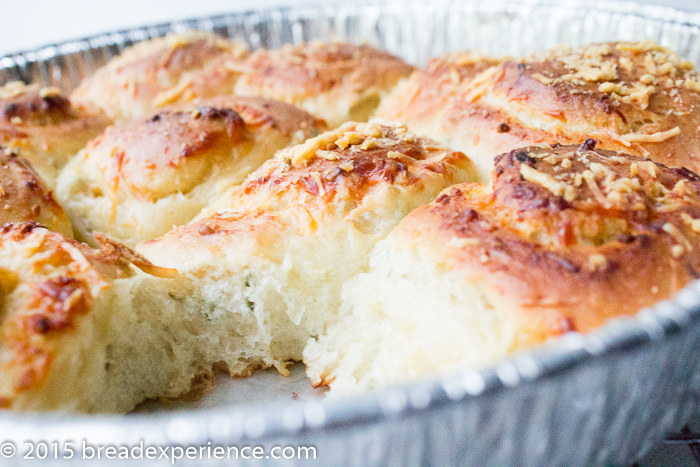
These crazy rolls are the monthly bake for the Bread Baking Babes. Our hostess, Karen of Bake My Day challenged us to make cinnamon rolls without cinnamon, and she also introduced us to an interesting method for making them. She calls these rolls wacky because they utilize three different types of leavening: yeast, baking soda and baking powder.
In addition to making the rolls without cinnamon, she implored us to answer these questions: What are your thoughts on the leavening? Why not use just yeast, or only the other two?
Why the extra leavening?
There are a lot of thoughts on the interwebs about this subject. Some speculate that it doesn’t work to use the three leavening agents together. Still others say that using one will offset the other and you won’t get the intended benefits.
I decided to define the purpose of each of these elements and speculate on why each one was used in this recipe. I welcome your thoughts as well.
We’ll start with yeast. The purpose of using yeast in breads is to develop the gluten so the dough has structure and can hold its shape. Yeast breads typically benefit from a slow rise, are stronger and more toothsome, and can have that wonderful yeasty smell and flavor. Some bakers, including me, love that smell!
Quick breads on the other hand, are chemically leavened with baking soda or baking powder or both, so that they rise quickly and have a more tender crumb.
Baking powder is used in quick breads or batter breads, to facilitate a fast rise and improve the texture of the loaf. Quick breads do not benefit from overmixing and need to be baked as soon as the leaving has been incorporated or they end up dense and gummy.
Using a little baking powder in a yeast bread can act as a dough enhancer to improve the texture of the bread, but not the necessarily the rise. In this recipe, you’ll notice that the baking powder and baking soda are incorporated after the yeast has had a chance to start working and before you roll out the dough. I’ve heard that some bakers incorporate a little baking powder in their pizza dough so this would make sense. One drawback with using baking powder is that because it’s a chemical leavening, it can leave an aftertaste. Therefore, you wouldn’t want to use very much.
Baking soda acts as a neutralizer so perhaps it is used in this bread to change the pH balance to make the rolls less acidic and to help them brown more quickly. Usually, you’ll see baking soda paired with buttermilk to neutralize the acidity of the buttermilk. However, these rolls call for regular milk. So I wonder if the job of the baking soda in these rolls is to neutralize the chemical aftertaste of the baking powder.
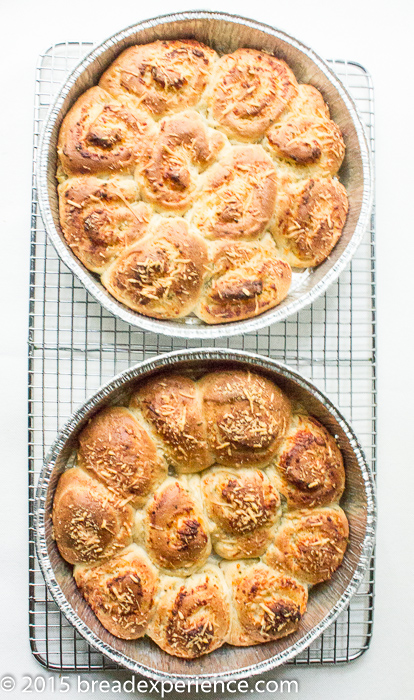
This was an interesting experiment. These rolls were really fluffy! However, my son and I noticed a slightly strange aftertaste when eating them right after they were baked. That aftertaste diminished after the rolls had a chance to rest for a little while. We thought it was because I used too much garlic or cheese (which still could be the case). I also wonder if it was because I let them rest twice in the refrigerator. Because I put the dough in the refrigerator twice, I’m not sure that these rolls really benefited from the extra leavening, but I will say that the dough was really bubbly when I rolled it out to form the log.
I enjoyed these rolls, but I’m not convinced the added leavening was necessary. Perhaps another test is in order!
What are your thoughts on why all three leavening agents were used? Do you think the additional leavening is beneficial!
Non-Cinnamon Rolls made with Garlic Rosemary Cheese and Spelt
Makes:
18-20 rolls (enough to fill two 8-inch round pans)
Adapted from Cinnamon Rolls by The Pioneer Woman
Notes from Karen: This recipe basically follows the rules for making rolls, as in: make the dough, bulk rise. Roll out in a rectangle, add filling of your choice, roll up from the long side and cut into slices. Proof and bake in a moderate oven. Now the difference lies in the leavening combo and that comes to show in the rising method.
Ingredients:
- 240 grams/1 cup milk, scalded, then cooled
- 30 grams /1/8 cup olive oil
- 1 tablespoon organic sugar
- 1 teaspoon instant yeast
- 260 grams /~2 cups all-purpose spelt
- 43 grams / ~1/3 cup all-purpose spelt, reserved
- 1/4 heaping teaspoon baking powder
- 1/4 scant teaspoon baking soda
- 4 grams / 3/4 teaspoon Sea salt
- 2-3 tablespoons fresh Rosemary, coarsely chopped
- Minced or roasted garlic, to spread on dough, to taste
- Shredded Asiago and Parmesan, added to the dough and sprinkled on top, as desired
- Extra olive oil for spreading on the dough, if desired
Directions:
In a large bowl, whisk together 260 grams spelt flour, sugar, and yeast. Mix the cooled milk and oil together and pour over the dry ingredients.
Stir until combined, cover with a kitchen towel and let rise for 1 hour.
In a separate bowl, whisk together the remaining 43 grams of flour, chopped rosemary, baking powder, baking soda and salt. Add to the dough and stir thoroughly to combine.
Cover with plastic wrap or a kitchen towel and place in the refrigerator for at least an hour.
Chilling the dough: You may now proceed to roll out the dough in a rectangle or refrigerate for at least an hour or up to 3 days. (Keep an eye out for overflowing dough; punch down if it rises to the top). This is a relatively slack dough so it is easier to work with when chilled!
Proceed as you will with any other rolls you make; roll dough into a large rectangle on a floured surface. Don’t roll it too thin or the ingredients might ooze out.
To make the filling, use your imagination… go sweet, go savory, go wacky. Make it yours and make it good!
Now it’s time to roll the dough into a long log. Start with the long side closest to you and roll away from your body. Keep a tight roll. Once you have your roll, pinch the seam and roll it once over so the seam is on the bottom.
Chill the rolled log if necessary: My log was fairly slack so I placed it on a baking sheet, covered it with plastic wrap and put it back in the refrigerator for 30 -45 minutes to make it easier to slice.
Slice into 1.1/2 inch thick slices. Cover and set aside to rise for at least 20-45 minutes before baking. I sliced my slices a bit thinner so I ended up with more smaller rolls. I liked the smaller rolls, but feel free to make them bigger.
Bake for 15-18 minutes in a preheated oven (375F/190C)
And that’s it! Enjoy! These rolls taste best warm.
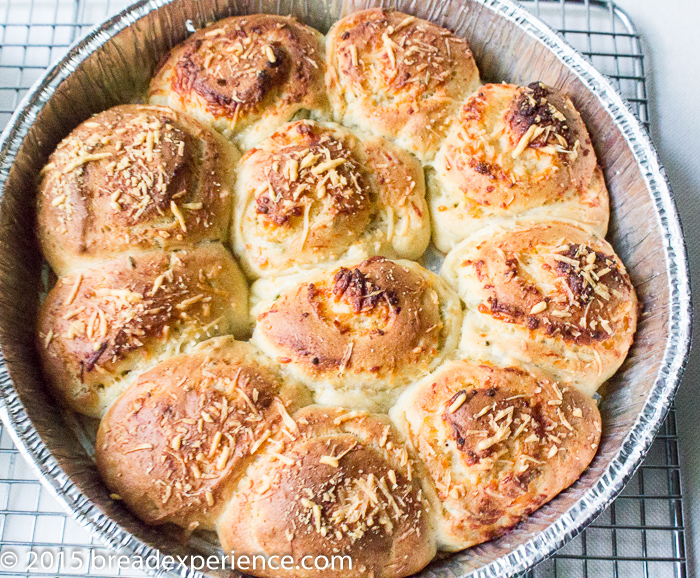
We invite you to bake these rolls and tell us all about it, by baking, blogging, sending your pictures and details to Karen no later then the 29th of this month.
Make the rolls your own. Surprise us with your imagination. Let us know what you think about the leavening. Why not use just yeast, or only the other two? Yes, you need to use all three in this recipe.
Karen of Bake My Day is the host kitchen for April for the Bread Baking Babes. Details on how to participate in this month’s bake, can be found on Karen’s post.
And please do check out the breads the other Babes made. Links to the babes are below the graphic.
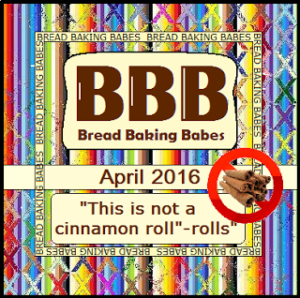
– Karen
blog from OUR kitchen – Elizabeth
Bread Experience – Cathy
All Roads Lead to the Kitchen – Heather
Judy’s Gross Eats – Judy
Karen’s Kitchen Stories – Karen
My Diverse Kitchen – Aparna
My Kitchen In Half Cups – Tanna
Notitie Van Lien – Lien
Thyme for Cooking – Katie (Bitchin’ Bread Baking Babe Bibliothécaire)
A Messy Kitchen – Kelly
Life’s a Feast – Jamie
Ilva Beretta Food Photography – Ilva
Happy Baking!
Cathy
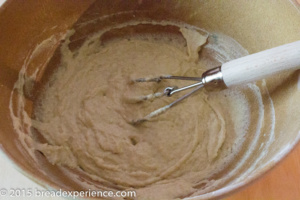
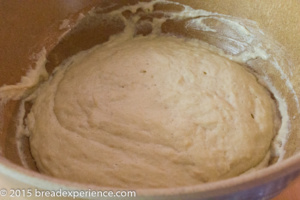
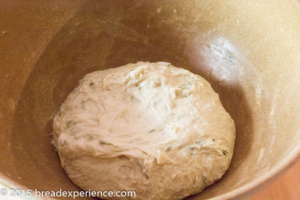
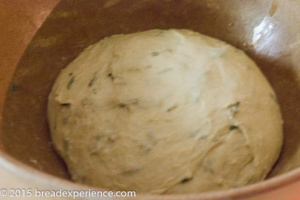
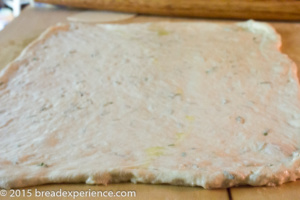
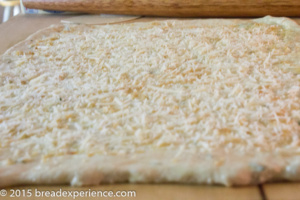
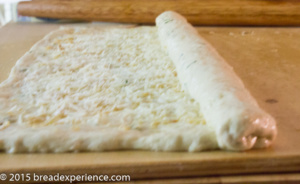
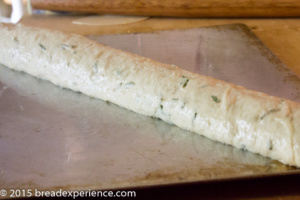
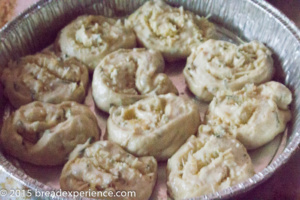
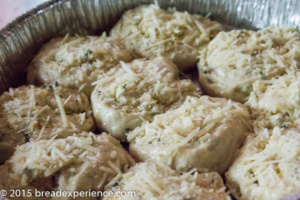
Baking Soda says
After reading a lot about the benefits/effects of using either or both baking soda and baking powder I think the summary you gave is what it is about… then again… necessary? Still not sure. I planned to bake the same recipe just using yeast but didn’t get to it in time.
I think you tasted the baking soda right after baking. I have the same taste when I bake soda bread and don’t let it cool enough.
Love your choice of filling! I am a savory girl!
Cathy says
Thanks Karen! That makes sense. I do need to try these exact rolls again but with just yeast.
Karen says
I love your filling, and I love your idea of chilling the rolled up dough before slicing. Mine was soooo slack! Even so, they kind of prop each other up in the pan. Thanks for your speculation on the leavens. Great research!
Cathy says
Hi Karen, chilling the dough before rolling definitely helped.
Tanna says
Clearly these are not cinnamon rolls but equally clearly these are fabulous rolls. And even more clearly, I must bake these again. I almost just did these as garlic rolls but yours go so much further along. Wonderful
Cathy says
Thanks Tanna! I enjoyed them as garlic rolls for sure. I love rosemary so it was an added plus.
Kelly says
Love those flavors! And they are beautiful too. 🙂
Cathy says
Thanks Kelly!
Elizabeth says
Garlic, cheese and rosemary! I really like the look of the golden cheese gratings on top!
When I was wandering around the internet to learn more about using more than one leavener in bread, I noticed the thing about baking soda neutralizing the acid of buttermilk. I wonder if the original recipe (that Drummond’s mother had – or was it her grandmother??) was made with buttermilk.
After doing that brief research, it made less and less sense to me that the baking soda and baking powder would be added before the fridge rest. I’m thinking that might have been the reason you had the strange aftertaste. Everything I’ve seen about using baking soda and baking powder says that they’re designed to work immediately (baking soda really immediately and baking powder seems to require heat to get it to really do its CO2 production).
Cathy says
Yes, I wondered about the buttermilk as well. As for the rest in the fridge, I let it rest twice because it was so slack. That could definitely be the issue.
Katie Zeller says
Garlic, rosemary and cheese…. Oh. My. I’ll have these please. And they’re pretty. (we like pretty)
Cathy says
Thanks Katie!
Lien says
O yes, even though I’m a girl with a sweet tooth, the combination of garlic, rosemary (or any herb) and cheese is just mouth watering! Your house must have smelled fantastic!
My dough was very very slack, even though I didn’t use all the milk.
I was confused that while there was baking soda, no acidic ingredients were in the dough, as that is necessary to make the gas, I don’t think it has any use in the dough here.
I didn’t study it really, but internet can give a lot of contradicting explanations. For me I’ll just use instant yeast next time, as I like the bread-like texture in buns.
Cathy says
Those were my thoughts as well. It was an interesting experiment.